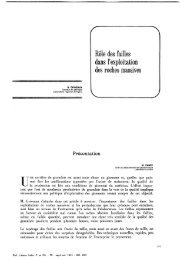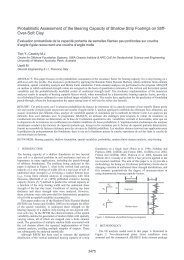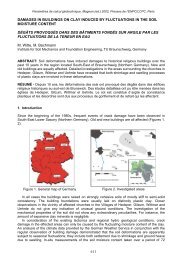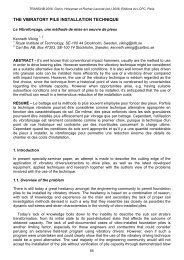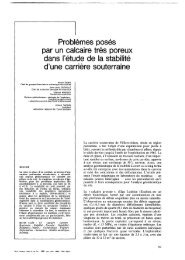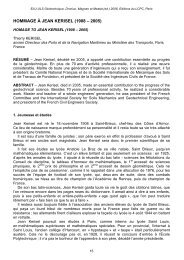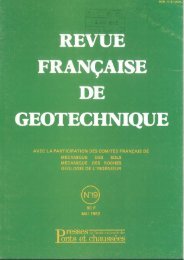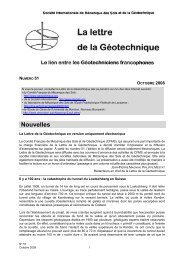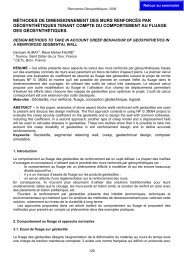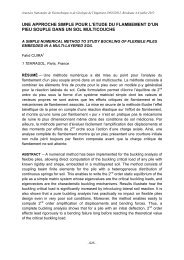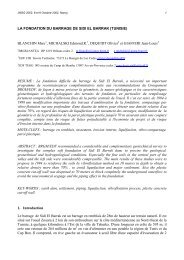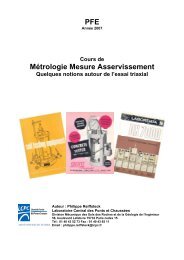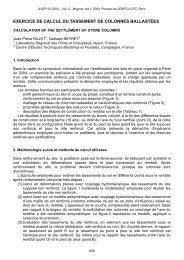Improvement of soft fat clay using rigid inclusions and vertical drains
Improvement of soft fat clay using rigid inclusions and vertical drains
Improvement of soft fat clay using rigid inclusions and vertical drains
Create successful ePaper yourself
Turn your PDF publications into a flip-book with our unique Google optimized e-Paper software.
Proceedings <strong>of</strong> the 18 th International Conference on Soil Mechanics <strong>and</strong> Geotechnical Engineering, Paris 2013Nevertheless, below the embankment, there is no concrete slabor <strong>rigid</strong> structure like for the foundation <strong>of</strong> the bridge.Reinforced earth with galvanized steel was designed to hold thelarge horizontal forces <strong>of</strong> active earth pressure. Because <strong>of</strong> thelarge geotextile deformations during the consolidation period, asshown in the following monitoring results, the decision wasmade to use a stronger more <strong>rigid</strong> construction with nearly nodeformation. Compared with plastic geotextiles, the steel gridmaterial has only very small elastic deformations, <strong>and</strong> as aresult limiting the horizontal deformations <strong>of</strong> the embankment.Through the addition <strong>of</strong> some gravel in parts <strong>of</strong> the s<strong>and</strong>y loadtransfer platform LTP, the friction between LTP <strong>and</strong> CMC wasgreatly increase <strong>and</strong> nearly no deformation was necessary tomobilize the friction <strong>of</strong> the LTP.5.2 Controlled Modulus Columns CMCSeveral measurement systems were installed between the CMC<strong>and</strong> the reinforced earth in the load transfer platform. Theinstruments show an almost perfect full stress concentration <strong>of</strong>the load on the CMC <strong>and</strong> less than one centimetre <strong>of</strong> horizontaldeformation. Figure 10 shows the cross section <strong>and</strong> the 5<strong>vertical</strong> deformation measurements over a period <strong>of</strong> 2 years.The horizontal inclinometer was laid across six marked CMCcolumns(figure 1 <strong>and</strong> figure 9). A settlement <strong>of</strong> one centimetre<strong>of</strong> the top <strong>of</strong> the CMCs <strong>and</strong> two centimetres in-between CMC inthe reinforced earth steel construction were measured. Therewas a good agreement between the calculated values <strong>of</strong> thesettlement <strong>and</strong> the results <strong>of</strong> the monitoring.5 MONITORING RESULTS5.1 Wick <strong>drains</strong>Figure 10. horizontal inclinometer results with arround 1 cm <strong>of</strong> CMCsettlements <strong>and</strong> 2 cm <strong>of</strong> reinforced earth settlementsFigure 8. measurement at the settlement plates SP 9 und SP10.6 SUMMARY AND CONCLUSIONSS<strong>of</strong>t <strong>and</strong> <strong>fat</strong> <strong>clay</strong> were found at the B5 / B202 road crossing.Additional soil investigations <strong>and</strong> laboratory tests wereperformed to be able to complete a proper design, regardingstability <strong>and</strong> consolidation time.Oedometer consolidation tests allowed to precisely predict themovements during the consolidation processes that wereaccelerated by the use <strong>of</strong> <strong>vertical</strong> <strong>drains</strong> at different spacings.Large deformations <strong>of</strong> up to 1.5 m <strong>of</strong> settlements <strong>and</strong> 27 cm <strong>of</strong>horizontal displacement were experience <strong>and</strong> closely match thecalculations <strong>and</strong> show that it was the right decision not to placethe highest embankment directly on the s<strong>of</strong>test soil beside thebridge over the running traffic on the highway B5.Vibration free CMC in combination with reinforced earthallowed to construct this high embankment with less than twocentimetre differential settlements to the piled bridge.With a careful planning <strong>of</strong> the work within the overallconstruction schedule, detailed design combined with anextensive monitoring program, economic soil improvementtechniques can be combined with deep foundations in oneproject even on very s<strong>of</strong>t soil can be treated successfully.7 REFERENCESFigure 9. <strong>vertical</strong> inclinometer results at the 7 m high damm with <strong>drains</strong><strong>and</strong> 600 kN/m vowen geotextileThe measured settlements during the consolidation process infigure 8 follow very closely the predictions shown in figure 7.An additional strong geotextile layer <strong>of</strong> 600 kN/m tensilestrength between the embankment <strong>and</strong> the <strong>vertical</strong> <strong>drains</strong> had27 cm <strong>of</strong> deformation measured with <strong>vertical</strong> inclinometers.DIN Deutsches Institut für Normung, 2002, DIN 4094-4: Subsoil –field testing – part 4 : Field vane test.DIN Deutsches Institut für Normung, 2001, DIN EN 12699: Execution<strong>of</strong> special geotechnical work - Displacement piles; German versionJ-L Chaumeny, J.F.Kirstein, S. Varaksin, 2008, An experience <strong>of</strong>consolidation <strong>of</strong> extremly s<strong>of</strong>t mud for one <strong>of</strong> Europe’s largestprojects “The AIRBUS A-380” factory in Hamburg, Glasgow.2516



